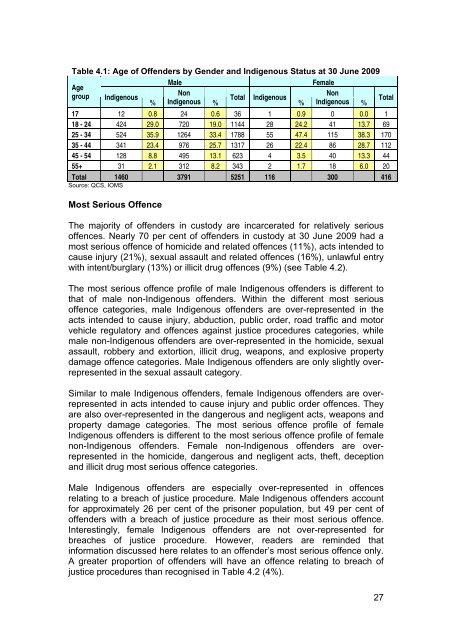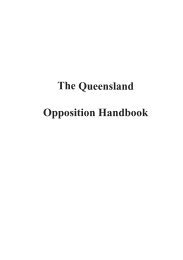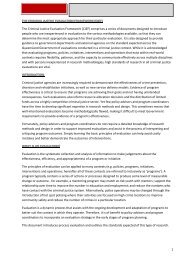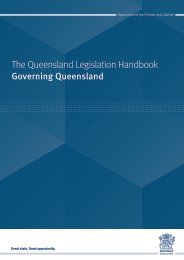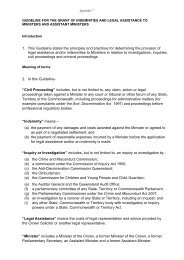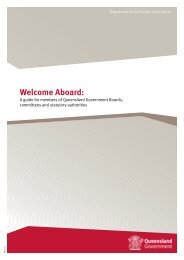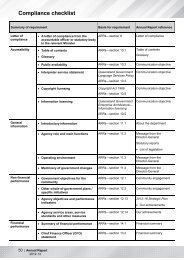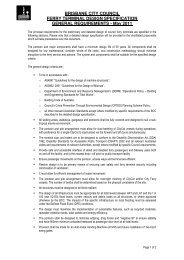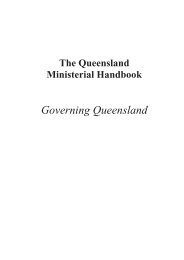Rehabilitative needs and treatment of Indigenous offenders in ...
Rehabilitative needs and treatment of Indigenous offenders in ...
Rehabilitative needs and treatment of Indigenous offenders in ...
Create successful ePaper yourself
Turn your PDF publications into a flip-book with our unique Google optimized e-Paper software.
Table 4.1: Age <strong>of</strong> Offenders by Gender <strong>and</strong> <strong>Indigenous</strong> Status at 30 June 2009MaleFemaleAgegroup <strong>Indigenous</strong>Total <strong>Indigenous</strong>%Non<strong>Indigenous</strong> %%Non<strong>Indigenous</strong> %17 12 0.8 24 0.6 36 1 0.9 0 0.0 118 - 24 424 29.0 720 19.0 1144 28 24.2 41 13.7 6925 - 34 524 35.9 1264 33.4 1788 55 47.4 115 38.3 17035 - 44 341 23.4 976 25.7 1317 26 22.4 86 28.7 11245 - 54 128 8.8 495 13.1 623 4 3.5 40 13.3 4455+ 31 2.1 312 8.2 343 2 1.7 18 6.0 20Total 1460 3791 5251 116 300 416Source: QCS, IOMSMost Serious OffenceThe majority <strong>of</strong> <strong>of</strong>fenders <strong>in</strong> custody are <strong>in</strong>carcerated for relatively serious<strong>of</strong>fences. Nearly 70 per cent <strong>of</strong> <strong>of</strong>fenders <strong>in</strong> custody at 30 June 2009 had amost serious <strong>of</strong>fence <strong>of</strong> homicide <strong>and</strong> related <strong>of</strong>fences (11%), acts <strong>in</strong>tended tocause <strong>in</strong>jury (21%), sexual assault <strong>and</strong> related <strong>of</strong>fences (16%), unlawful entrywith <strong>in</strong>tent/burglary (13%) or illicit drug <strong>of</strong>fences (9%) (see Table 4.2).The most serious <strong>of</strong>fence pr<strong>of</strong>ile <strong>of</strong> male <strong>Indigenous</strong> <strong>of</strong>fenders is different tothat <strong>of</strong> male non-<strong>Indigenous</strong> <strong>of</strong>fenders. With<strong>in</strong> the different most serious<strong>of</strong>fence categories, male <strong>Indigenous</strong> <strong>of</strong>fenders are over-represented <strong>in</strong> theacts <strong>in</strong>tended to cause <strong>in</strong>jury, abduction, public order, road traffic <strong>and</strong> motorvehicle regulatory <strong>and</strong> <strong>of</strong>fences aga<strong>in</strong>st justice procedures categories, whilemale non-<strong>Indigenous</strong> <strong>of</strong>fenders are over-represented <strong>in</strong> the homicide, sexualassault, robbery <strong>and</strong> extortion, illicit drug, weapons, <strong>and</strong> explosive propertydamage <strong>of</strong>fence categories. Male <strong>Indigenous</strong> <strong>of</strong>fenders are only slightly overrepresented<strong>in</strong> the sexual assault category.Similar to male <strong>Indigenous</strong> <strong>of</strong>fenders, female <strong>Indigenous</strong> <strong>of</strong>fenders are overrepresented<strong>in</strong> acts <strong>in</strong>tended to cause <strong>in</strong>jury <strong>and</strong> public order <strong>of</strong>fences. Theyare also over-represented <strong>in</strong> the dangerous <strong>and</strong> negligent acts, weapons <strong>and</strong>property damage categories. The most serious <strong>of</strong>fence pr<strong>of</strong>ile <strong>of</strong> female<strong>Indigenous</strong> <strong>of</strong>fenders is different to the most serious <strong>of</strong>fence pr<strong>of</strong>ile <strong>of</strong> femalenon-<strong>Indigenous</strong> <strong>of</strong>fenders. Female non-<strong>Indigenous</strong> <strong>of</strong>fenders are overrepresented<strong>in</strong> the homicide, dangerous <strong>and</strong> negligent acts, theft, deception<strong>and</strong> illicit drug most serious <strong>of</strong>fence categories.Male <strong>Indigenous</strong> <strong>of</strong>fenders are especially over-represented <strong>in</strong> <strong>of</strong>fencesrelat<strong>in</strong>g to a breach <strong>of</strong> justice procedure. Male <strong>Indigenous</strong> <strong>of</strong>fenders accountfor approximately 26 per cent <strong>of</strong> the prisoner population, but 49 per cent <strong>of</strong><strong>of</strong>fenders with a breach <strong>of</strong> justice procedure as their most serious <strong>of</strong>fence.Interest<strong>in</strong>gly, female <strong>Indigenous</strong> <strong>of</strong>fenders are not over-represented forbreaches <strong>of</strong> justice procedure. However, readers are rem<strong>in</strong>ded that<strong>in</strong>formation discussed here relates to an <strong>of</strong>fender’s most serious <strong>of</strong>fence only.A greater proportion <strong>of</strong> <strong>of</strong>fenders will have an <strong>of</strong>fence relat<strong>in</strong>g to breach <strong>of</strong>justice procedures than recognised <strong>in</strong> Table 4.2 (4%).Total27


